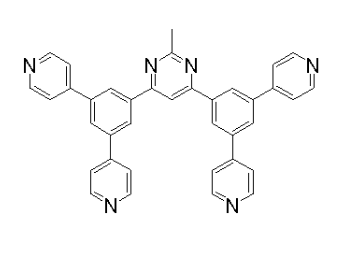4,6-Bis(3,5-di(pyridin-4-yl)phenyl)-2-MethylpyriMidine CAS#: 1030380-51-8; ChemWhat Code: 17508
Identification
| Product Name | 4,6-Bis(3,5-di(pyridin-4-yl)phenyl)-2-MethylpyriMidine |
| IUPAC Name | 4,6-bis(3,5-dipyridin-4-ylphenyl)-2-methylpyrimidine |
| Molecular Structure |  |
| CAS Registry Number | 1030380-51-8 |
| EINECS Number | No data available |
| MDL Number | MFCD29369281 |
| Beilstein Registry Number | No data available |
| Synonyms | 4,6-bis(3,5-di(pyridin-4-yl)phenyl)-2-methylpyrimidineB4PyMPM |
| Molecular Formula | C37H26N6 |
| Molecular Weight | 554.657 |
| InChI | InChI=1S/C37H26N6/c1-25-42-36(34-20-30(26-2-10-38-11-3-26)18-31(21-34)27-4-12-39-13-5-27)24-37(43-25)35-22-32(28-6-14-40-15-7-28)19-33(23-35)29-8-16-41-17-9-29/h2-24H,1H3 |
| InChI Key | WCXNEXQHQNXXEA-UHFFFAOYSA-N |
| Canonical SMILES | Cc1nc(-c2cc(-c3ccncc3)cc(-c3ccncc3)c2)cc(-c2cc(-c3ccncc3)cc(-c3ccncc3)c2)n1 |
| Patent Information |
| No data available |
Physical Data
| Appearance | White Powder |
| Solubility | No data available |
| Flash Point | No data available |
| Refractive index | No data available |
| Sensitivity | No data available |
| Melting Point, °C | Solvent (Melting Point) |
| 374 |
Spectra
| Description (NMR Spectroscopy) | Nucleus (NMR Spectroscopy) | Solvents (NMR Spectroscopy) | Frequency (NMR Spectroscopy), MHz |
| Chemical shifts | 1H | chloroform-d1 | 400 |
| Description (IR Spectroscopy) | Comment (IR Spectroscopy) |
| Bands, Spectrum | |
| Spectrum | film |
| Description (Mass Spectrometry) |
| Spectrum |
| Description (UV/VIS Spectroscopy) | Comment (UV/VIS Spectroscopy) |
| Spectrum | |
| Spectrum | film |
Route of Synthesis (ROS)
| Conditions | Yield |
| With potassium phosphate; tris-(dibenzylideneacetone)dipalladium(0); tricyclohexylphosphine In 1,4-dioxane; water for 24h; Inert atmosphere; Reflux; Synthesis of B4PyMPM Next, the intermediate compound A (4.6 g, 11.9 mmol), 4-pyridineboronic acid pinacol ester (10.8 g, 52.6 mmol), tris(dibenzylideneacetone)dipalladium(0) (Pd2(dba)3) (0.43 g, 0.48 mmol), tricyclohexylphosphine (PCy3) (0.322 g, 1.15 mmol), and a potassium phosphate aqueous solution (1.35 mol/L, 138 ml) were added to a three-neck flask under a nitrogen atmosphere, and the mixture was stirred for 24 hours in a dioxane (440 ml) solvent. A reaction solution was mixed with water, and a precipitated solid was extracted by filtration. The precipitated solid was suspended and washed with pure water to obtain a white solid. Additionally, the obtained white solid was sublimated and purifled to obtain B4PyMPM (6.67 g, yield 77%) that is a target compound. | 77% |
Safety and Hazards
| GHS Hazard Statements | Not Classified |
Other Data
| Transportation | NONH for all modes of transport |
| Under the room temperature and away from light | |
| HS Code | 290621 |
| Storage | Under the room temperature and away from light |
| Shelf Life | 1 year |
| Market Price | USD |
| Druglikeness | |
| Lipinski rules component | |
| Molecular Weight | 554.654 |
| logP | 6.854 |
| HBA | 6 |
| HBD | 0 |
| Matching Lipinski Rules | 2 |
| Veber rules component | |
| Polar Surface Area (PSA) | 77.34 |
| Rotatable Bond (RotB) | 6 |
| Matching Veber Rules | 2 |
| Use Pattern |
| 4,6-Bis(3,5-di(pyridin-4-yl)phenyl)-2-MethylpyriMidine CAS 1030380-51-8 Used as Electron/Hole transport Materials;It is mainly used in the field of OLED and other organic optoelectronic materials as a functional material to improve device efficiency and stability. |
Buy Reagent | |
| No reagent supplier? | Send quick inquiry to ChemWhat |
| Want to be listed here as a reagent supplier? (Paid service) | Click here to contact ChemWhat |
Approved Manufacturers | |
| Want to be listed as an approved manufacturer (Requires approvement)? | Please download and fill out this form and send back to approved-manufacturers@chemwhat.com |
Other Suppliers | |
| Watson International Limited | Visit Watson Official Website |
Contact Us for Other Help | |
| Contact us for other information or services | Click here to contact ChemWhat |


